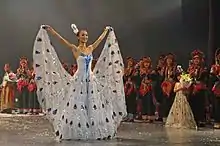Yang Liping
Yang Liping (Chinese: 杨丽萍; pinyin: Yánglí Píng; born 10 November 1958) is a Chinese dancer and choreographer of Bai ethnicity. She rose to fame for choreographing and performing "The spirit of Peacock" in 1986. She was the first dancer from Mainland China that went to Taiwan to perform in 1992. She is known across China for her creativity and her performance of the Dai peacock dance. Yang has been dubbed as the "Peacock Princess of China".[1] She has performed over 1000 shows and toured to over 30 countries and regions, including Philippine, Singapore, Russia, US, Canada, Taiwan, Japan and Australia.[2]
Yang Liping | |||||||
|---|---|---|---|---|---|---|---|
 Yang is performing in a concert | |||||||
| Born | November 10, 1958 Wen Qiang village, Cibihu town, Dali, Yunnan province | ||||||
| Nationality | Chinese | ||||||
| Alma mater | Minzu University of China | ||||||
| Occupation | |||||||
| Years active | 1971–present | ||||||
| Title | Princess of Peacock, Dancing Goddess | ||||||
| Spouse(s) | Liu Chunqing (m. 1995) | ||||||
| Relatives | Yang Cai Qi (Niece) | ||||||
| Chinese name | |||||||
| Traditional Chinese | 楊麗萍 | ||||||
| Simplified Chinese | 杨丽萍 | ||||||
| |||||||
Early life and family
Yang was born November 10, 1958 in Wen Qiang village, Cibihu town, Dali city, Yunnan province. She is the eldest of four children. Her parents and grandparents, members of the Bai ethnic minority, were farmers in a nearby village. Her grandmother was a singer in the village.[1] She was born during the Great Chinese Famine and lived a hard life.[3] She moved to Xishuangbanna Dai Autonomous Prefecture with her family when she was nine.[4] Fearful of persecution in Cultural Revolution, Yang's father left his family. 11-year-old Yang and her mother supported the whole family.[5][6]
Career
Yang began her formal dance training at the late age of 11 at a dance troupe in the Xishuangbanna area of Yunnan, after her family moved to the area. In the Southern flatland of Yunnan, Xishuangbanna borders the country of Burma and is dominated by the Dai ethnic group, whose Peacock dance she would become synonymous with. In 1971 took on the role of "Peacock Princess" in the Xishuangbanna Song and Dance Troupe's narrative dance drama Zhaoshuzhun yu nanmunuona[7].
In her early 20s, after she moved to Beijing to dance with the Central Nationalities Song and Dance Ensemble, she made the Daomeilan's version of the peacock dance her own, recasting parts of it with deft arm and finger movements. In 1986, that choreography and dance won her first prize in a national competition.[1] She rose to national level fame in 1986 when she won first prize in a national dance competition for her original solo "Spirit of the Peacock" (雀之灵). Ever since, she has been dubbed the "Peacock Princess".
She was the director, choreographer and star of "Dynamic Yunnan", a show that drew sellout crowds all over China. She toured Europe and the United States in 2005. In 2004, "Dynamic Yunnan" won five major awards at the National Lotus Awards, including Gold Award for Dance Spectacular, Best Choreography and Best Female Performer. To create the exotic song and dance spectacular "Dynamic Yunnan", Yang spent years traveling to remote villages of the 26 ethnic minority tribes in Yunnan and selected over 60 villagers who had the natural gift of song and dance, from whom she built an archive re-creating this rich feast of sight and sound.[1] It is part of a trilogy that that the directed and choreographed between 2004 and 2008: "Dynamic Yunnan", "Echoes of Shangri-la" and "Tibetan Myth".
In May 2009, she revealed a dance and music production 'Yunnan Sound', at the Yunnan Art Institute's Experimental Theater. On November 17, 2009, US President Barack Obama is visit to China, she performed the classic dance "The Spirit of the Birds" at the Great Hall of the People.[8] She is currently a judge on So You Think You Can Dance China.
Choreographic works
- Moonlight[9]
- Pilgrimage to Lhasa[10]
- Two trees[11]
- 雨丝[12]
- Fire[13]
- Red temptation[14]
- Daughter of the country[15]
- Spirit of the Peacock[16]
- Romantic peacock [17]
- Echoes Of Shangrila[18]
- Under Siege—The Full Story of Farewell My Concibine[19]
- Dynamic Yunnan[20]
- Peacock of Winter[21]
- The Peacock[22]
- Shangrila Dynamic Yunnan[23]
- Dynamic Huangshan[24]
Personal life
Yang's first husband was a colleague of the Central National Song and Dance Troupe and later divorced. Her current husband, Liu Yuqing, is a Taiwanese-American. They couple met in 1990 and married in 1995, but Yang wants to dance long-term dieting and cannot be pregnant.[25]
References
- Barboza, David (5 March 2005). "The Peacock Princess of China". The New York Times.
- "白族的孔雀精灵-杨丽萍_名家_中华舞蹈网". 2014-02-21. Archived from the original on 2014-02-21. Retrieved 2020-05-27.
- "《年代访》对话杨丽萍:纷乱世界 我看到万物真相". 凤凰网. 2013-12-02. Retrieved 2014-02-06.
- "杨丽萍与她的故乡". 人民日报海外版. 2001-04-11. Retrieved 2014-02-06.
- 庞清辉. "杨丽萍:一个舞蹈家的传奇". 人民网. 人民文摘. Retrieved 2020-05-26.
- 张道正. "著名舞蹈家杨丽萍:我没有那么好 只是生逢其时". 中国新闻网. Retrieved 2020-05-26.
- "西双版纳音乐舞蹈资源的产业开发与思考 - 中国知网". www.cnki.net. doi:10.16230/j.cnki.yyxb.2008.01.006.html. Retrieved Nov 23, 2020.
- "杨丽萍:用舞蹈来养活灵魂-博宝艺术网 时间". Art Xun (in Chinese). 21 December 2009.
- "杨丽萍艺术". www.yangliping.com. Retrieved Nov 23, 2020.
- "杨丽萍艺术". www.yangliping.com. Retrieved Nov 23, 2020.
- "杨丽萍艺术". www.yangliping.com. Retrieved Nov 23, 2020.
- "杨丽萍艺术". www.yangliping.com. Retrieved Nov 23, 2020.
- "杨丽萍艺术". www.yangliping.com. Retrieved Nov 23, 2020.
- "杨丽萍艺术". www.yangliping.com. Retrieved Nov 23, 2020.
- "揭54岁杨丽萍终身不育内幕 老公系台湾富豪-搜狐娱乐". Sohu (in Chinese). 25 September 2012.
External links
- Yang Liping photo - Dynamic Yunnan by Yang Liping (500px)
- Yang Liping photo - Dynamic Yunnan by Yang Liping (PhotoSIG)
- Yang Liping Video produced by Makers: Women Who Make America